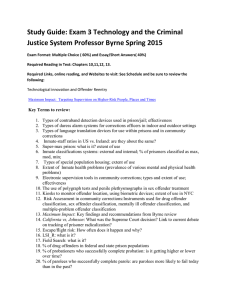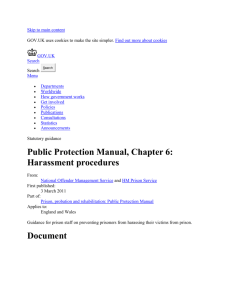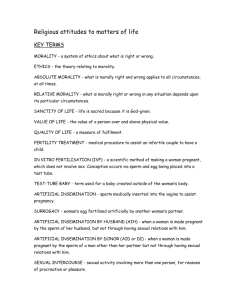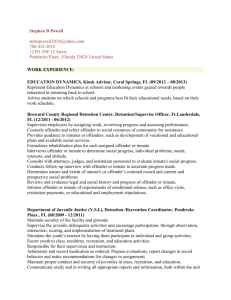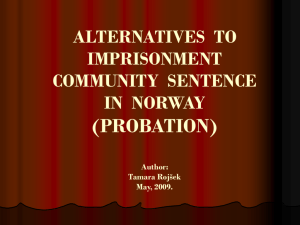Fundamentals of Corrections
advertisement
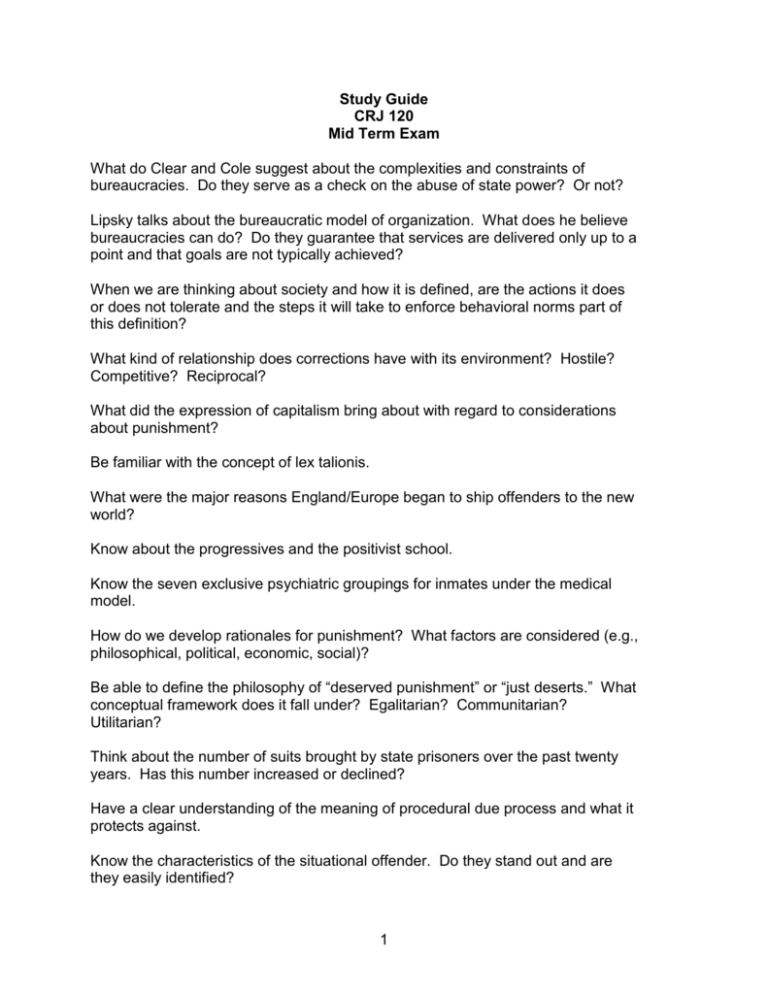
Study Guide CRJ 120 Mid Term Exam What do Clear and Cole suggest about the complexities and constraints of bureaucracies. Do they serve as a check on the abuse of state power? Or not? Lipsky talks about the bureaucratic model of organization. What does he believe bureaucracies can do? Do they guarantee that services are delivered only up to a point and that goals are not typically achieved? When we are thinking about society and how it is defined, are the actions it does or does not tolerate and the steps it will take to enforce behavioral norms part of this definition? What kind of relationship does corrections have with its environment? Hostile? Competitive? Reciprocal? What did the expression of capitalism bring about with regard to considerations about punishment? Be familiar with the concept of lex talionis. What were the major reasons England/Europe began to ship offenders to the new world? Know about the progressives and the positivist school. Know the seven exclusive psychiatric groupings for inmates under the medical model. How do we develop rationales for punishment? What factors are considered (e.g., philosophical, political, economic, social)? Be able to define the philosophy of “deserved punishment” or “just deserts.” What conceptual framework does it fall under? Egalitarian? Communitarian? Utilitarian? Think about the number of suits brought by state prisoners over the past twenty years. Has this number increased or declined? Have a clear understanding of the meaning of procedural due process and what it protects against. Know the characteristics of the situational offender. Do they stand out and are they easily identified? 1 What does Brownmiller say about the relationship between women and those who murder them? When thinking about jails in this country, what are some of the conclusions that Clear and Cole reveal. Are they staffed with well-trained personnel? Do the staff have the requisite knowledge to deal with offenders with mental problems? Do jails frequently promote rehabilitation programs? If not, what might be some of the reasons for this? Think about the population that is in jail. Who are they? Are they the affluent in the community or are jails populated with citizens from the lower tier of the socioeconomic pyramid? When a person is denied bail, or they simply cannot afford it, what does this period of pretrial detention do to them? Are they likely to go to court and exuberantly defend their innocence? Or, conversely, are they more likely to plea bargain even if they did not commit the crime? What is the primary function of the presentence investigation and who does it? Where did the idea of presentence investigations, supervisions conditions, social casework, reports to the court, and revocation of probation come from? What does it mean when one is sentenced to “community service”? According to the text, is there strong evidence that traditional probation is ineffective with serious offenders? With all the changes that have occurred in American prisons over the last decade, would it be safe to say that there has been a dramatic shift from the treatment model of corrections? Almost half of today’s prison population have either been incarcerated or on probation at least twice. Is this a true statement? Read about Walpole State Prison in Massachusetts. The essential business of corrections is to what? Rehabilitate? Deter? Enable retribution? Punish offenders? Which state has the largest prison population? Clear and Cole describe some of the controversies, issues, and themes that arise in the study of corrections. These are divided into two main areas. What are they? 2 The actions and practices of individuals and institutions designed to induce conformity with the norms and rules of society is known as what? In the past, removal from society was sometimes used as punishment for breaking the rules. What term is used to describe this form of punishment? What effects did the Enlightenment have on society? Know which religious group was responsible for implementing humanistic ideas in America while at the same time, influencing correctional reform. With the rise of the medical model, the emphasis of corrections shifts to what? What was the aim of the Pennsylvania System? What was the aim of the New York System was to: Know what term is used to describe when a sentence is given with a specific number of years rather than a range of years. People who feel that we should ‘lock ‘em up and throw away the key’ are promoting which correctional goal? What do we call punishment that is designed to repair damage to both victim and community? In the case Bounds v. Smith, what did the court say inmates must have free access to? According to Clear and Cole, what were the overall results of the turbulent inmate rights period? Which Court decision held that the basic elements of procedural due process must be present when decisions are made concerning the disciplining of an inmate? Prior to the 1960s, which approach did the courts use with regard to inmate rights? In recent years, what can we say about America’s prison population? Has it become less violent? More diverse? Older? Younger? Fatter? Thinner? Blacker? Whiter? In other words, know the demographics of contemporary prisons. What term do we use to describe an offender whose limited mental development prevents adjustment to the rules of society? What is the average stay between arrest and trial in our jails? 3 What do we know about the majority of defendants who appear in court? Know the specific demographics of the contemporary defendant. There are many different types of “alternative sanctions.” Know what they, the type of offender each is used for, and whether or not the public trusts them to be appropriate forms of punishment. You can use the CD-ROM that came with your book to find this answer. Know the difference between the situational offender, the career criminal, the mentally ill offender, the mentally handicapped offender, the sex offender. etc. What is the most commonly used sanction in the U.S.? Which model of incarceration is based on the assumption that the period of confinement should be for the purpose of incapacitation, deterrence, or retribution. 4
